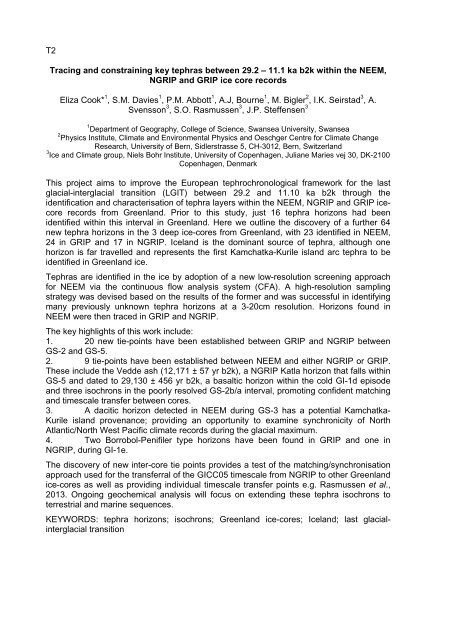The full programme book (PDF) - Royal Geographical Society
The full programme book (PDF) - Royal Geographical Society
The full programme book (PDF) - Royal Geographical Society
Create successful ePaper yourself
Turn your PDF publications into a flip-book with our unique Google optimized e-Paper software.
T2<br />
Tracing and constraining key tephras between 29.2 – 11.1 ka b2k within the NEEM,<br />
NGRIP and GRIP ice core records<br />
Eliza Cook* 1 , S.M. Davies 1 , P.M. Abbott 1 , A.J, Bourne 1 , M. Bigler 2 , I.K. Seirstad 3 , A.<br />
Svensson 3 , S.O. Rasmussen 3 , J.P. Steffensen 3<br />
1 Department of Geography, College of Science, Swansea University, Swansea<br />
2 Physics Institute, Climate and Environmental Physics and Oeschger Centre for Climate Change<br />
Research, University of Bern, Sidlerstrasse 5, CH-3012, Bern, Switzerland<br />
3 Ice and Climate group, Niels Bohr Institute, University of Copenhagen, Juliane Maries vej 30, DK-2100<br />
Copenhagen, Denmark<br />
This project aims to improve the European tephrochronological framework for the last<br />
glacial-interglacial transition (LGIT) between 29.2 and 11.10 ka b2k through the<br />
identification and characterisation of tephra layers within the NEEM, NGRIP and GRIP icecore<br />
records from Greenland. Prior to this study, just 16 tephra horizons had been<br />
identified within this interval in Greenland. Here we outline the discovery of a further 64<br />
new tephra horizons in the 3 deep ice-cores from Greenland, with 23 identified in NEEM,<br />
24 in GRIP and 17 in NGRIP. Iceland is the dominant source of tephra, although one<br />
horizon is far travelled and represents the first Kamchatka-Kurile island arc tephra to be<br />
identified in Greenland ice.<br />
Tephras are identified in the ice by adoption of a new low-resolution screening approach<br />
for NEEM via the continuous flow analysis system (CFA). A high-resolution sampling<br />
strategy was devised based on the results of the former and was successful in identifying<br />
many previously unknown tephra horizons at a 3-20cm resolution. Horizons found in<br />
NEEM were then traced in GRIP and NGRIP.<br />
<strong>The</strong> key highlights of this work include:<br />
1. 20 new tie-points have been established between GRIP and NGRIP between<br />
GS-2 and GS-5.<br />
2. 9 tie-points have been established between NEEM and either NGRIP or GRIP.<br />
<strong>The</strong>se include the Vedde ash (12,171 ± 57 yr b2k), a NGRIP Katla horizon that falls within<br />
GS-5 and dated to 29,130 ± 456 yr b2k, a basaltic horizon within the cold GI-1d episode<br />
and three isochrons in the poorly resolved GS-2b/a interval, promoting confident matching<br />
and timescale transfer between cores.<br />
3. A dacitic horizon detected in NEEM during GS-3 has a potential Kamchatka-<br />
Kurile island provenance; providing an opportunity to examine synchronicity of North<br />
Atlantic/North West Pacific climate records during the glacial maximum.<br />
4. Two Borrobol-Penifiler type horizons have been found in GRIP and one in<br />
NGRIP, during GI-1e.<br />
<strong>The</strong> discovery of new inter-core tie points provides a test of the matching/synchronisation<br />
approach used for the transferral of the GICC05 timescale from NGRIP to other Greenland<br />
ice-cores as well as providing individual timescale transfer points e.g. Rasmussen et al.,<br />
2013. Ongoing geochemical analysis will focus on extending these tephra isochrons to<br />
terrestrial and marine sequences.<br />
KEYWORDS: tephra horizons; isochrons; Greenland ice-cores; Iceland; last glacialinterglacial<br />
transition
















